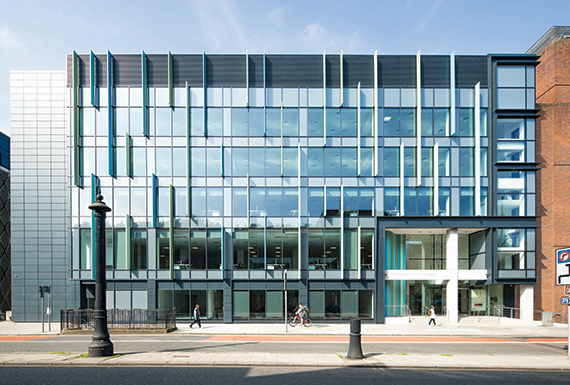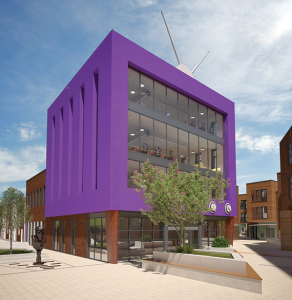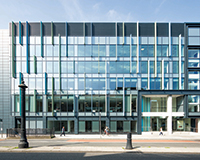 Will a wave of inshoring float the Bristol office market in the next two years? Plenty of property folk are gambling it will. David Thame reports
Will a wave of inshoring float the Bristol office market in the next two years? Plenty of property folk are gambling it will. David Thame reports
Inshoring is the great hope of many regional office markets, and none feels a greater sense of entitlement than Bristol. The claim is that the city’s strong legal scene, funky tech and media sector, and established financial services market put it in pole position to nab cost-conscious agile-working relocators from London.
Locals believe the appeal is enhanced by being in the sunny South West – think surfing, cream teas and long weekends – and Bristol being the regional city closest to London by travel time.
Nobody is sure how many inshoring requirements are hovering over Bristol, and only very brave souls will guess how many of this uncertain number will convert into deals. Some agents claim up to 1m sq ft is in play – others suggest perhaps 300,000 sq ft out of 700,000 sq ft of named known office requirements.
Even the 300,000 sq ft figure could be an overstatement because in some agents’ minds it includes 100,000 sq ft of regional consolidation from HMRC and a smaller 50,000 sq ft requirement from the Department for Work and Pensions. The conservative best guess is that 100,000-150,000 sq ft of inshoring is in play, of which an unguessable proportion will be converted into signed leases.
Jeremy Richards, lead director at JLL, is one of those keen not to get overexcited. JLL data suggests that between them the UK’s Big Six regional cities (including Bristol) scored just 1.4m sq ft of inshoring relocations in the 18 months from September 2014 to March 2016. Bristol can claim 46,000 sq ft from Spanish insurer Mapfre in late 2014, followed by a 78,000 sq ft move from EDF, although it took a year to sign the lease. All good news, and very welcome, but scarcely a tsunami, and rather less than the 233,000 sq ft Big Six average.
“We have not yet captured as much inshoring as we anticipated,” says Richards – and this view is widely shared.
On the upside, while there might not be much of it, there is at least some of it. Phil Morton, senior director at CBRE, says: “For the first time in 20 years the relocation scene feels real.”
The sense of reality is enhanced by some under-the-radar inshoring from the big law firms. Martin Booth, partner at Knight Frank, explains: “Sizeable inshoring requirements rarely appear from nowhere – instead they start with a small requirement, then gradually grow it. So we had Simmons & Simmons take 7,800 sq ft in Bristol in 2012, that figure is now up to 14,000 sq ft, and I would be very surprised if it doesn’t take more. Similarly, Reynolds Porter Chamberlain took 14,000 sq ft and is now looking for up to 25,000 sq ft.”
In the distance, some can see US influence. Cushman & Wakefield director Andy Heath says: “I suspect we will see that US-parented businesses are providing much of the energy for inshoring.”
Nobody expects big deals soon, and delays to the electrification of the Great Western rail line (due 2017, now arriving 2017/18, maybe) do not help the city sell itself.
There are hints that larger insurance companies and smaller TMT businesses are sniffing around, but nothing is confirmed. Limited supply of grade-A office space – a very short list headed by 53,000 sq ft at NFU Mutual/Salmon Harvester’s 2 Glass Wharf– combines with a sense that inshoring requirements are few and hard to convert, to prompt many observers to push back the big inshoring deals to 2017 and beyond.
Peter Musgrove, head of the Bristol office at Lambert Smith Hampton, says: “Small inshoring requirements are dipping their toes into Bristol, but I think we will have to wait to early 2017 to see anything big, probably because the supply of new office space is so limited.”
Musgrove is tracking some big requirements looking at Bristol and other regional centres – one as large as 200,000 sq ft – and believes the chance of something landing is growing. He says: “I was a bit pessimistic 12 months ago, when we saw some public sector requirements look at Bristol then not move, but since then we have seen London occupiers start to look at regionalising their property portfolio and we are now talking to occupiers looking for 20,000-30,000 sq ft.”
However, he adds: “Inshoring is a window of opportunity of just three to four years. We will get a couple of big relocations in that time, but after that the opportunities will narrow.”
An assured pipeline of inshoring requirements would improve the confidence of speculative developers Cubex Land and Palmer Capital, which are behind the 95,500 sq ft Aurora building at Finzels Reach (due for completion in late 2017), and Commercial Estates’ Group’s 200,000 sq ft Aspire scheme.
Yet developers and landlords might be better off looking to Bristol’s hinterland for new occupational demand, rather than scanning the horizon for arrivals from London. Evidence is mounting that Bristol is extending its pulling power deeper into the South West, and that this is producing a steady stream of new office requirements.
Simon Price, head of agency at Alder King, says: “We have evidence of regional consolidation in Bristol. We have certainly had half a dozen relocations from Bath.”
Knight Frank’s Booth agrees. “You can produce a long list of Bath relocators – I can come up with three recently adding up to more than 30,000 sq ft, all coming to Bristol because there is basically no commercial space in Bath. We have also seen relocations from Trowbridge, and law firms arriving in Bristol from further south.”
That said, relocations from Bristol’s hinterland will be limited – not only by the South West’s geography (long and thin, with Bristol at one end) but by the region’s relatively small-scale occupiers.
CBRE’s Morton warns: “Yes, Bristol is robbing occupiers from Bath, but I am not sure we are robbing more than we always have. And we aren’t yet robbing Exeter or Weston-super-Mare.”
Send for the lawyers
If Bristol lands a haul of inshoring deals, the likelihood is they will be from lawyers.
The city already has the largest legal sector by floorspace of any UK city outside London – CBRE estimates 874,000 sq ft. But there is room to improve. Just 27 of the top 100 law firms are represented in the city, compared to 42 in Manchester, and Bristol is in third place based on number of legal fee-earners – 1,546 compared to Manchester’s 2,038.
A 20,000 sq ft legal requirement is circling the market and three others are known to be comparing Bristol to other Big Six cities.
CBRE’s Phil Morton says: “Bristol is a centre of excellence and law firms are inshoring, Bristol has to be in with a shout.”
Recent moves include Veale Wasbrough Vizards taking 40,000 sq ft at Standard Life Investments Heritage With Profits Fund’s 67,000 sq ft Narrow Quay House (pictured).
Peter Musgrove at Lambert Smith Hampton says demand from law firms arrives at a convenient time because indigenous legal demand has worn thin. “Demand from existing local law firms is slowly dying – most of the big moves have already happened,” he says.
Defurbs
Refurbs are yesterday and defurbs are cool in a Bristol market scrambling for tech and media occupiers.
Stripped-back buildings – sometimes fitted only to shell and core – are being offered in the hope of appealing to hipster tenants. The bulk of the 350,000 sq ft of refurbished floorspace reaching completion in Bristol in the next 12 months is expected to be defurbed.

 If there is a king of Bristol defurbs, then it is Ashley Nicholson, director at Verve Properties. A 50,000 sq ft funky third phase at the Paintworks (pictured) is under construction and will complete in 2018. A fourth phase of 35,000 sq ft plus residential will go before planners next month and is expected to start on site as soon as phase three is completed.
If there is a king of Bristol defurbs, then it is Ashley Nicholson, director at Verve Properties. A 50,000 sq ft funky third phase at the Paintworks (pictured) is under construction and will complete in 2018. A fourth phase of 35,000 sq ft plus residential will go before planners next month and is expected to start on site as soon as phase three is completed.
However, defurb is not cheap. Verve’s Brewhouse cost £80 per sq ft to fit out. Nicholson says: “The danger is that developers simply jump on the defurb bandwagon and produce to a formula. Tech and creative operators will quickly spot clichés. A baseball hoop in an office does not make it cool.”
Resolution Properties is in the midst of a £2m defurb of the 89,000 sq ft Colston Tower. Something similar is planned for the 180,000 sq ft Pithay acquired last year. Asset manager James Baker says: “Young people are priced out of London, so are start-ups, and the grade-B space they might have moved to has largely been converted to residential, so we saw an opportunity. We have maximised ceiling heights and natural light and have 5,000 sq ft on the top two floors in solicitors’ hands.”
Baker insists Resolution is not over-relying on relocators. “We don’t plan to export Shoreditch to Bristol. We are talking to Bristol-based occupiers and entrepreneurs,” he says.
Harry Badham, head of development at AXA IM Real Assets, fights shy of the word “defurb” but agrees its 240,000 sq ft Assembly Bristol scheme will not have a standard fit-out. “We are going for higher ceilings and big windows because that is what occupiers want,” he says. “Other than that, occupiers can have whatever they like.”
Quoting rents vary, but whispers suggest £26-27 per sq ft for the best new defurbs – nudging the £30-£32 per sq ft-plus quoted for new grade-A stock built to traditional specifications.
CBRE’s Phil Morton says: “The days when landlords gave a discount for not fitting raised floors and suspended ceilings are long gone.”
Bristol offices in numbers:
783,199 sq ft
Bristol office take-up in 2015
1.26m sq ft
Bristol office take-up in 2014
874,000 sq ft
total floorspace occupied by law firms in Bristol
1,546
legal fee earners in Bristol
* Source: BNP Paribas Real Estate and CBRE











